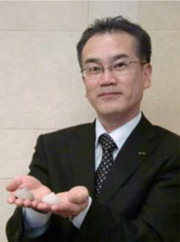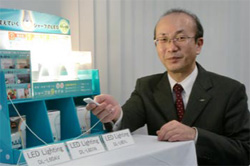Home > Highlighting JAPAN > Highlighting Japan FEBRUARY 2011 > Factory Floors of the Future
Highlighting JAPAN
COVER STORY: Sustainable Cities
Factory Floors of the Future
In Japan, environmental initiatives are underway on the production floors of many leading manufacturers. Miho Kawasaki introduces two ventures whose sustainable operations have been instrumental in boosting their competitiveness.

Haruyuki Mizuno of INAX holds samples of the company's newly developed water-retentive ceramic. When used as a roofing material, the ceramic absorbs rainwater, which cools the building when it evaporates.
Credit: MIHO KAWASAKI
Innovations to Reduce CO2 Emissions
INAX, a well-known manufacturer of sanitary ware in Japan, set itself a target in 2008 of reducing total CO2 emissions in 2050 by 80% compared to 1990 levels.
Haruyuki Mizuno, officer and general manager of INAX's Sustainable-Innovation Department, explains, "We had been making efforts in everyday office activities such as consistency in conserving packaging resources, using recycled raw materials, and switching the company cars to hybrid cars. However, when we investigated CO2 emissions for every department in the company, we found that sanitary ware and tile ceramics accounted for approximately 80%. To achieve our target, it was vital to revise the ceramics technologies that consumed huge amounts of fossil fuel. At the existing plant, the high temperatures extended to the area around the firing kiln for firing tiles and toilet bowls. That is to say, it was an indication that thermal energy was going to waste. We decided to introduce a regenerative burner, which made it possible to reuse the thermal energy that we were unable to use in the past and set up control technologies."
A regenerative burner is a system for storing the high-temperature waste heat generated at the time of firing, and sending the heat to the firing kiln to be reused for heating up the air for combustion. When firing ceramics, air must also be sent into the kiln at the same time as the fuel, and using air heated to a high temperature raises combustion efficiency, making it possible to conserve energy. In testing, the burners reduced CO2 by approximately 30% compared to conventional kilns. The testing stage has now been completed. In the future, the company aims to move from firing techniques that heat the entire kiln to develop technologies that transmit heat only to the product, and research is also underway on drying technologies for ceramics that use microwaves similar to a microwave oven. The company has also started to examine ways to supply its own natural energy such as solar and wind power.
"Monodzukuri manufacturing is our foundation," says Mizuno. "We would like to produce ceramic products capable of contributing to society while working to reduce CO2 on the production floor."

Takuo Mori of Sharp's Green Front Sakai Planning Center
Credit: MIHO KAWASAKI
Cooperation Is Key with LCDs
Sharp, the world's leading producer of LCD (liquid crystal display) panels, has been operating a new plant incorporating advanced environmental measures in Sakai City, Osaka Prefecture since 2009. At present, this is the only plant in the world capable of processing approximately 3-meter-square glass substrate into large-size LCD panels that are used in televisions and so on.
Next to the LCD plant is a plant that supplies the world with solar cell panels, which are becoming popular as a clean energy source. The most important feature of the plant is Green Front Sakai, an industrial complex centering on Sharp but which also brings together nineteen companies in various industries that are vital for producing LCD panels (such as glass substrate, color filters, energy-related companies and distribution) on the same premises. By jointly managing the energy used at each plant, the companies conserve energy on a major scale.
The initiatives to reuse energy go beyond the corporate frameworks. For example, heat generated in the manufacturing process at the glass factory is used to purify the water for cleaning LCD panels. In addition, each factory building is linked with a transport system which not only reduces the production lead time of LCD panels and intermediate stock, but also brings major reductions in the CO2 emissions by eliminating transport by trucks on the premises.
From the outdoor lights to the vending machines, all the lighting on the premises is energy-efficient, long-life LED lighting. Water-permeable blocks made using discarded LCD panels are embedded in the walkways. There is also a plan to install solar panels on the roofs of each factory. Near Green Front Sakai, Kansai Electric Power is building a large-scale solar generation facility using thin-film solar cell panels manufactured in Green Front Sakai.
Furthermore, each company at Green Front Sakai uses IT to share information about the flow of the supply chain, from production planning to process management and shipments, making for high production efficiency.
Takuo Mori, general manager of the Green Front Sakai Planning Center, comments, "The most surprising thing for visitors who come for tours is that the cooperative structure of nineteen companies functions as if Green Front Sakai were one company. About forty years ago Sharp was the first company in the world to use liquid crystal in the displays of calculators. Today, Green Front Sakai makes it possible to achieve high productivity through advanced environmental measures thanks to the cooperative spirit and trusting relationship of member companies fostered over forty years while developing the market for liquid crystal displays."
© 2009 Cabinet Office, Government of Japan






